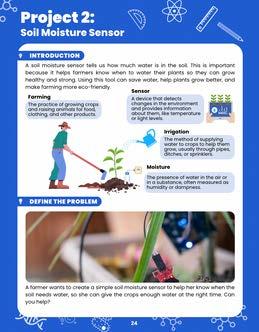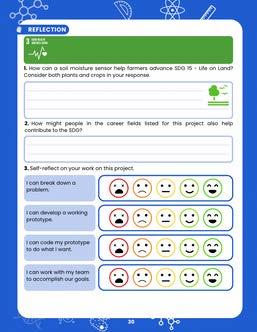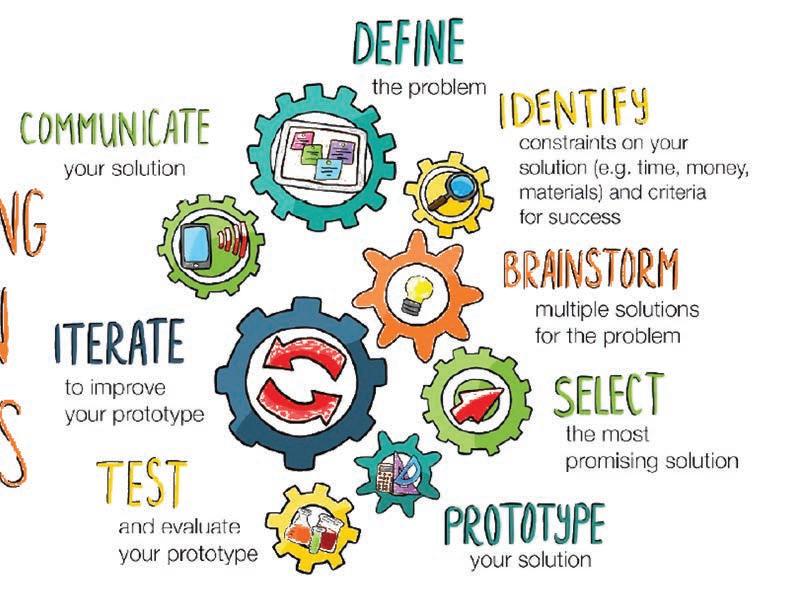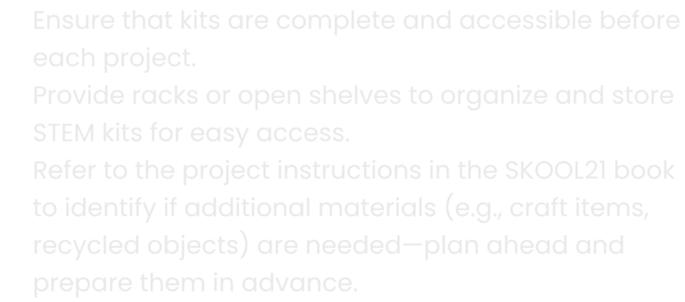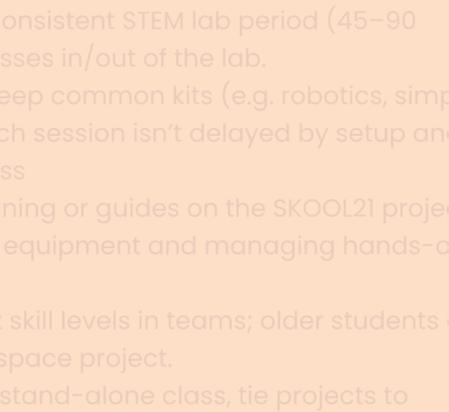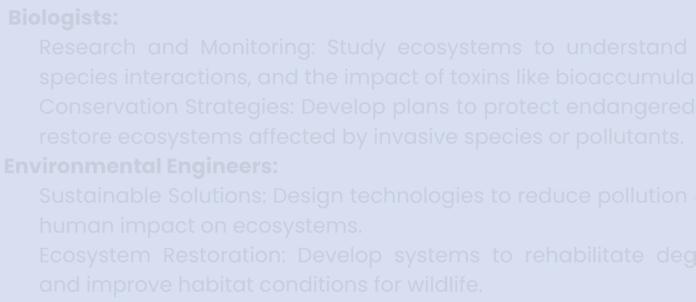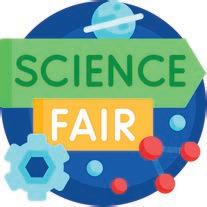TeacherGuide-STEMUNOLevel9
Teacher Guide
Copyright©2024
Copyright © 20
Author: NatashaKarampela
Editors: LindseyOwnandErinGoodwin
ISBN: 978-981-17737-3-0
Publishedby:
SKOOL21PTE.LTD.-Singapore
DUOTower,Level8#831
3FraserStreet,189352,Singapore
Allrightsreserved,firstedition2024. Nopartofthisbookmaybereproduced,distributed,ortransmittedinanyformorby anymeans,includingphotocopying,recording,orotherelectronicormechanical methods,withoutthepriorwrittenpermissionofthepublisher,exceptinthecaseof briefquotationsembodiedincriticalreviewsandcertainothernon-commercialuses permittedbycopyrightlaw.
Forpermissionsorinquiries,pleasecontact:
Email: info@skool21.org
Website: https://skool21.org
Preface WelcometotheFutureofTeachingandLearning! Welcome to th
Thank you for joi designed not on meaningful, han young innovato science, technol
BuildingonaStrongFoundation Each level of the
novators series is teachers to lead es, you will guide challenges using creating a strong
Thankyouforjoiningusonthisexcitingjourney!TheSKOOL21STEMInnovatorsseriesis designednotonlytoignitecuriosityinstudentsbutalsotoempowerteacherstolead meaningful,hands-onSTEMlearningexperiences.Throughthisseries,youwillguide younginnovatorsastheyexplore,design,andsolvereal-worldchallengesusing science,technology,engineering,andmathematics(STEM).
EachleveloftheSKOOL21STEMseriesbuildsuponthepreviousone,creatingastrong continuumoflearning—fromsimplemachinestoadvanced3Dmodeling.Students travelthroughkeytechnologicaleras,fromtheIndustrialRevolutiontothe innovationsshapingourfuture.Nomattertheirstartingpoint,everylearnerwill discovernewskillsanddeeperunderstandingalongtheway.
LearningbyDoing AtSKOOL21,webelievestudentslearnbestbydoing.Eachbookcomeswitha comprehensiveSTEMkit,enablingstudentstobuild,test,andexploreconcepts throughhands-onchallenges.Asateacher,youwillfacilitateengagingprojects wherestudentsactivelycreate,problem-solve,andapplycriticalthinkingskills—all whilehavingfun.
MakingaReal-WorldImpact Everyprojectisdesignedtoconnectlearningtoreal-worldissues,inspiredbythe SustainableDevelopmentGoals(SDGs).Throughthesechallenges,studentsseehow theirideascancontributetosolvingproblemslikecleanwateraccess,renewable energy,andenvironmentalconservation—empoweringthemtoenvisionabetter world.
TeachingLikeaPro TheSKOOL21STEMprogramalignswithinternationalstandardsandbestpractices, ensuringthatbothteachersandstudentsaredevelopingthecollaboration, innovation,anddesignthinkingskillsvaluedintoday’sworld.You’renotjust supportingschoolwork—you’repreparingthenextgenerationofthinkers,leaders, andchangemakers.
Building on a not just leaders, and c
IntroductiontotheKit TheSKOOL21STEMUNOLearningKitisahands-onelectronicsandcodingkit designedforstudentsinLevel9.UsedalongsidetheSTEMInnovators Handbook,thiskitintroducesstudentstoprogramming,electronics,and automationthroughreal-worldprojects.
AttheheartofthekitistheATmega328Pmicrocontroller,programmedusing theC++languagethroughtheArduinoplatform.Learnersexplorehow hardwareandsoftwareworktogetherbybuildingprojectslikemotorcontrol systems,sensor-basedinputs,andmore.
TechnicalFeatures
LessonStructure Eachlessoninthehandbookfollowsastructuredformattoensureclarityand effectiveimplementation.Asamplesolutionisalsofoundattheendofeach lesson.Thestructureincludes:
Lessonobjectives NGSSStandards
CambridgeScienceStandards
ISTEStandardsConnections
CambridgeMathStandards
CommonCoreMathStandards
DefinetheProblem Studentsareintroducedtothescienceconcept andarelatedrealworldproblemtheyaretasked withsolving.
GettingStarted Everyprojectbeginswithguidedfirststeps.This helpsthestudenttoconfidentlytacklethe challengewithasolidfoundation.
DesignandPlan Build-Test-Improve Studentsbrainstormindividually,thencollaborate withtheirteamtocomeupwiththebestdesign plan.
Studentscollaboratetobuild,test,andimprove models.Then,theypracticegivingandreceiving constructivefeedback.
MathandScienceConnection/Reflect Studentsconnecttheirlearningbacktothe academicobjectivesandanswerguided reflectionquestions.
TheEngineeringDesignProcess ocess TheEngineeringDesignProcess(EDP)isasystematicapproachusedby engineersanddesignerstosolveproblemsandcreateinnovativesolutions.It providesastructuredframeworkfordevelopingnewproducts,processes,or systemsbyfollowingaseriesofwell-definedsteps.Thisprocessisnotonly applicableinengineering,butisalsowidelyusedinvariousSTEMdisciplinesto tacklechallengesanddevelopcreativesolutions.
Forstudentsinfirstgradeandabove,thetypicalEngineeringDesignProcess followsmultipleiterativesteps,includingidentifyingaproblem,researching, brainstorming,designing,prototyping,testing,andrefiningsolutions.
Thisstructuredapproachencouragescreativity,criticalthinking,anditeration, formingastrongfoundationforfutureSTEMlearning.
forming a str
FosteringSocialSkills STEMactivitiesnaturallybuildkeysocialskills.Teacherscanhelpstudents practiceandstrengthentheseskillsbyguidingthemduringgroupwork, discussions,andprojectchallenges.
Keysocialskillsdevelopedinclude:
Encouragestudentstoshareideas andassignrolesduringgroup worktobuildteamworkand respectfordifferentperspectives.
Promptstudentstoask"why"and "whatif"questionswhensolving problemsordesigningsolutions.
Collaboration EmpathyandRespect
Remindstudentstovalue everyone'sideasandsupport peersbyusingkind,respectful language.
Coach studentstotalkthrough disagreementscalmlyandfind solutionsthateveryonecan accept.
Buildreflectionintotheprocessby askingstudentswhatworkedwell, whatwaschallenging,andwhat theywoulddodifferentlynexttime.
Communication
Modelclearcommunicationand askstudentstoexplaintheir thinkingandlistencarefullyto teammates.
Problem-Solving Challengestudentstotrydifferent strategieswhentheyface obstaclesandpraisepersistence.
TimeManagement Helpteamssetmini-deadlines andguidethemtobreakprojects intosmaller,manageabletasks.
PresentationSkills
Givestudentsregularchancesto presenttheirworktopeers,using clearspeakingandsupportive feedback.
Teamworking
Celebratestrongteamworkby recognizingwhenstudentsshare leadership,encourageeachother, andsolveproblemstogether.
TeachingSTEMalsoteachesstudentshowtothink,work,andlead.Byactively supportingsocialskillsduringprojects,teacherspreparestudentsnotjustfor academicsuccess,butforfuturecareersandlifechallenges.
academic su
MakerspaceSetup Amakerspaceisacreative,hands-onareawherestudentsexploreSTEM conceptsthroughbuilding,experimenting,andsolvingproblemstogether.This guideisdesignedforteacherswhoarenewtoSTEMandlookingforclearstepsto setupandmanageamakerspace.
SpaceDesign:
Chooseaclean,well-litspacewithroomtomove. Arrangetables/chairsinclustersof2–4students. Uselow,openshelvesforeasyaccesstomaterials. For30students,750–900sqftisrecommended (25–30sqftperstudenttoallowmovement, collaboration,andtool/machine/materialuse).
MaterialsManagement:
Ensurethatkitsarecompleteandaccessiblebefore eachproject.
Provideracksoropenshelvestoorganizeandstore STEMkitsforeasyaccess.
RefertotheprojectinstructionsintheSKOOL21book toidentifyifadditionalmaterials(e.g.,craftitems, recycledobjects)areneeded—planaheadand preparetheminadvance.
SharedResources:
ProvideoneSTEMkitpersmallgroup. Encourageteamworkbyhavingstudentsco-design andco-buildprojects.
SafetyFirst: Keep a fi
Setsimplesafetyrulesandreviewoften. Supervisealltooluseclosely. Keepafirst-aidkitinthespace.
STEMClassroomManagement STEMclassesarehands-on,highlyengaging,andoftennoisy—that’sagood thing!Butwithoutclearroutinesandstructures,theycanquicklybecome chaotic.Awell-managedmakerspaceallowsstudentstoexploreandinnovate safely,responsibly,andcollaboratively.
STEMClassSessionRoutine
Setaclearandconsistentstructuretoeachsessionsostudentsknowwhatto expectandstayfocused:
90-minuteproject (Grade3toGrade12)
Grade 3 to Grade 12)
5-minute
45-minuteproject (Pre-KtoGrade2)
o ect Pre-K to Grade 2)
SpaceOrganization:
Provideracksoropenshelvestostorekitsneatlyandaccessibly.
ToolandMaterialsRules:
Usetoolswithcare–noplayingormisusingmaterials.
Returneverythingtoitslabeledplace.
Askbeforetakingextrasupplies.
Handstoyourself—respectothers’creationsandspace.
Assignspecificworkzones:BuildArea,SupplyRack,QuietZone,Cleanup Station.
Keepaprojectmaterialchecklisttomakesurekitsarecompletebefore starting.
Onlyonegroupmember(MaterialManager)maycollectmaterialsatatime.
GroupManagementwithTeamRoles
Groupworkcanbemessywithoutstructure.SKOOL21encouragesstudent collaboration,sorotatingroleshelpsbalanceresponsibilityandensure activeparticipation:
Keepsteamontask,trackstime,encourages collaboration.
Collectskits/materialsfromtheteacher,ensuressupplies arereturnedpost-build.
Sharesoutcomes,challenges,andsolutionswiththeclass.
Evaluatesthemodel,givesfeedback,suggestschanges.
ImplementationGuide TheSKOOL21STEMInnovatorsHandbookoffersproject-basedSTEMlessonsfor Pre-KthroughGrade12.Teacherscanusethreemainmodelstoimplementthese projects:
IntegratedApproach EmbedSTEMprojectsintoexistingscienceandmathlessons.Forexample,a scienceunitonplantsmightincludeahands-onengineeringchallengefrom thehandbook.ThisalignsSTEMactivitiesdirectlywithcurriculumstandards andlearningobjectives.ResearchshowsthatteachingSTEM subjectstogether (aswithintegratedlessons)deepensunderstandingandretentionandmakes learningmorerelevantandconnectedtotherealworld.
Advantages:
Reinforcesrequiredscience/mathstandardswithhands-onapplication. Buildsproblem-solvingandcritical-thinkingskillsthroughproject-based learning.
Helpsstudentsseeconnectionsacrosssubjects(an“interconnected viewpoint”).
Usesexistingclasstime(noextraperiodsneeded),soSTEMisn’tanadd-on butpartofthecurriculum.
PracticalTips:
Alignprojectstolessons: ChooseSKOOL21projectsthatmatchyourunit goals(e.g.useasimplemachineprojectduringaforces&motionunit).
Startsmall: BeginwithashortSTEMactivity(one45-minutesession)ina scienceormathlesson,thenbuilduptolongerprojects.
Co-teachifpossible: Collaboratewithascienceormathcolleagueto shareplanningandbringindifferentexpertise.
Usegrade-appropriatepacing: ForPre-K–Grade2,integratea45-min STEMmini-projecteachweek;forGrade3+,youmightsplita90-min scienceperiodintolecture+projecttime.
connect
Emphasizestandards: SKOOL21projectsaredesignedtoalignwithNGSS, CommonCorestandards,Cambridgemathandscience.Highlightthese connectionsinyourlessonplantomeetacademicgoals.
Stand-AloneClassApproach ScheduleadedicatedSTEMclassormakerspacesession(e.g.aweekly90minutelabperiodorrotatingSTEM special).Inthismodel,studentsworkina makerspaceorlabwithtoolsandmachines(likeroboticskits,3Dprinters,craft materials,etc.).Amakerspaceis“acollaborativeworkspaceinsideaschoolfor making,learning,andexploring”.StudentsinteamstackleSKOOL21projects fromstarttofinish,usinghands-onmaterialsratherthanjusttextbooks.
Advantages:
Focusedhands-onlearning:Studentscantakeabstractconceptsand makethemconcrete(forexample,learningcircuitrybyactuallybuildinga papercircuit).
Resilienceandcreativity:Thetrial-and-errornatureofmakingteaches perseverance;studentslearntoiterateondesignswhenthingsdon’twork andthusdevelopgrit.
Equityandaccess:Awell-stockedSTEMlabgivesallstudents(including girlsandunder-representedgroups)equalaccesstotechandengineering tools.
PracticalTips: g
Scheduleregularly: BlockoutaconsistentSTEMlabperiod(45–90 minutes)eachweekorrotateclassesin/outofthelab.
Preparematerialsinadvance: Keepcommonkits(e.g.robotics,simple circuits,designsets)readysoeachsessionisn’tdelayedbysetupand leavetimeforcleanupduringclass
Trainteachers: ProvidebasictrainingorguidesontheSKOOL21projectsso teachersfeelconfidentusingtheequipmentandmanaginghands-on activities.
Groupstudentsthoughtfully: Mixskilllevelsinteams;olderstudentscan mentoryoungeronesinamakerspaceproject.
Blendwithcurriculum: Eveninastand-aloneclass,tieprojectsto standards(e.g.acodingprojectthatteachesmathlogicoradesign challengethatreinforcesphysicalscienceconcepts).
Extra-CurricularApproach RunSTEMprojectsasafter-schoolclubs,lunch-timeactivities,orsummer camps.Theseareoptionalprograms(STEMclubs,roboticsteams,coding camps,etc.)whereinterestedstudentscanexploreSKOOL21challengesmore freely.After-schoolSTEM“engagesstudentsinhands-on,real-worldprojects,” makingSTEMfeelexcitingandrelevant.
Advantages:
Extratimetoexplore:Studentsgetmorehourstoquestion,tinker,andlearn beyondthelimitedschoolday.Forexample,aweeklyroboticsclubmight meetforanhourafterschool.
Buildsinterestandidentity:Funclubactivitiessparkmotivationanda positiveattitudetowardSTEM,helpingstudentsdevelopaSTEMidentity.
Flexibleandstudent-driven:Studentsself-select;theyworkattheirown paceoncreativeprojects(e.g.codingagame,buildingamodelbridge).
Reachesdiverselearners:Clubscantargetdifferentagegroupsandskill levels–frombasicscienceforyoungerkidstoadvancedroboticsforteens. Thishelpsbridgeenrichmentgaps(makingSTEMopportunitiesavailableto allstudents).
PracticalTips: Keepitlow-stakes: Emphasizefunandcuriosityovergrades.Short,handsonprojects(likemini-challenges)keepstudentsengaged.
Advertisewidely: Inviteallstudents,notjusthigh-achievers.Useschool announcements,flyers,andparentnewsletterstoraiseawareness. Tietocompetitionsorshowcases: Useevents(sciencefairs,robotics tournaments)tomotivatetheextraeffort.
Leveragesummerorcamptime: Ifresourcesallow,runaweek-longSTEM summercampusingseveralSKOOL21projectsfordeeperimmersion.
Collaboratewithcommunity: Inviteguestspeakers(engineers,makers)or partnerwithlocallibraries/museumsformaterialsandinspiration.
HybridApproach (BlendingAllModels) Inpractice, manyschoolsuseamixofmodels.Ahybridapproachmight integratesimpleSTEMtasksintoregularlessonsandalsoofferadedicated STEMlabplusanafter-schoolclub.Thisway,everystudentgetssomeSTEM exposureandthosewholoveitcandivedeeper.
Whentointegrate: Usecurriculum-linkedprojectsduringcoreclasses.Forexample,inaGrade4mathclassyou mightuseaSKOOL21projectongearstoteachratios,orinscienceclassstudentsmight buildamodelecosystem.Smallerorsingle-sessionactivitiesfitwellhere.
Reservelonger,open-endedprojectsforSTEMclassorthemakerspace.Complex engineeringchallenges(robotdesign,3Dmodeling,advancedcoding)needlongerblocks, sothesesuita90-minSTEMperiodorseriesoflabsessions.
Offerstudentsaspaceforexplorationthatdoesn’tfitthecurriculumortimeline.These projectscanbedrivenbystudentinterestandcanspanseveralweekswithoutpressureto “coverthecurriculum.”
Usingahybridplanensuresflexibility.Teacherscanadapt:ifasemesteris heavywithtesting,leanonafter-schoolclubsforenrichment;whencovering standards,weaveSTEMintolessons.Alwayscheckthatevenfree-formprojects stilltouchacademicgoals.
(Note:SKOOL21projectsarealreadyalignedtoNGSSandCommonCore standards,CambridgeMathematicsandCambridgeScience,sowhether integratedorstand-alone,theysupportlearningobjectives.)
StandardsAlignment L e s s o
9Ss.05
1Joints
2WeightMachine
7SolubilityPredictor
9Gg.10
8Moments
60-90minSDG9HS-PS4-5 8Ps.01 1.4.a.,1.4.c.,HSG-SRT.C.8 9Gp.02
60-90minSDG8HS-PS2-5 8Pe.01
9PartcleModel
10Reflection
HSG.CO.A.2 9Gp.06
9As.04
60-90minSDG7HS-PS3-3 8ESp.02
60-90minSDG13HS-ESS2-4 8ESc.01
11Magnetometer
9Gp.03 1 2WindTurbines
13WeatherSeesaw
14Asteroids 60-90minSDG13HS-ESS1-4 9ESs.01,9ESs.02
15GlobalScienceImpact60-90minSDG16HS-PS4-5
LessonPlans andAnswerkey LearningContent
Project1:Joints LessonPlan Duration: 60-90minutes
Studentswillexplorethefunctionalityofhingeandball-and-socketjointsthroughcodingand buildingmodels.Theywilluseservomotorsandphysicalmaterialstosimulatejoint movementsandconnecttheirlearningtoreal-worldapplicationsinbiomechanicsand engineering.
LearningContent Bytheendofthelesson,studentswill:
1. Identifyanddifferentiatebetweenhingeandball-and-socketjointsinthehumanbodyand mechanicalsystems.
2. Programaservomotortomimicjointmovements.
3. Buildfunctionaljointmodelstodemonstratemovement.
4. Reflectonthereal-worldapplicationsofjointmodelsinphysicaltherapyandrobotics.
Vocabulary
Thepointwheretwobonesconnect,allowingmovement.
Ajointallowingmovementalongoneaxis,likeadoororelbow.
Ball-and-SocketJoint
Ajointallowingmulti-directionalmovement,likeashoulderorhip.
Materials
LearningActivities(Session1) Introduction
1. Askstudentstoobservehowtheirarmandlegjointsmove.Discusswhichjointsallow circularmotion(ball-and-socket)andwhichallowlinearmotion(hinge).
2. Showexamplesofhowthesebiologicaljointsinspireengineeringdesigns,likecarsteering mechanisms(ball-and-socket)anddoorhinges(hinge).
Khali,aphysicaltherapist,needsmodelstoteachherpatientsaboutjointmovements. Studentswillhelpbydesigningandprogrammingmodelsofhingeandball-and-socket jointsusingservomotorsandbuildingmaterials.
1. DistributeKidsUnomicrocontrollersandservomotors.
2. GuidestudentstoconnecttheKidsUnototheircomputersusingaUSBcable.
3. Assiststudentsinpluggingtheservomotorintoport13ontheKidsUno: Brownwire GND Redwire V Orangewire D13 Wire
Code 1. OpentheArduinoIDEanddemonstrate: Selecting"ArduinoUno"astheboardandensuringthecorrectUSBportisselected. Openingthe“ServoSweep”example.
2. Walkstudentsthroughmodifyingthecodetouseport13anduploadittotheKidsUno.
Build
1. Guidestudentsincreatingahingejointmodel: Usebuildingblocksandaservomotortoreplicatethe movementofahingejoint. Ensuretheservomotorissecurelyattachedand functional.
2. Askthemtointegratetheservomotorintothemodelsoit moveswhenpoweredbythecode.
1. Askstudentstotesttheirhingejointmodels.
2. Discusshowchangingthecodeorstructureaffectsthemovement.
3. Promptquestionslike:“Howdoesreducingthedelayaffectthejoint’sspeed?” Discover
Challenge
1. GuideStudentstoBuildaBall-and-SocketJoint.
2. Movearoundtheclassroomtoobservestudentsastheycut,assemble,andattachtheir components.
3. Provideindividualizedsupportforstudentswhoarestrugglingwithspecificsteps,suchas cuttingorstabilizingthestructure.
ShareandImprove(10minutes) 1. Havestudentspresenttheirjointmodelstotheclass,explainingthedesignprocessand functionality.
2. Useafeedbacktabletohighlightdesignstrengthsandsuggestimprovements.
3. Allowstudentstimetorefinetheirmodelsbasedonpeerandteacherfeedback.
AnswerKey
MATHANDSCIENCECONNECTION
ANSWER1
Theformulaforthecircumferenceofacircleis: C=2πr
Substituter=1andπ=3.14
C=2×3.14×1=6.28units
A3/4circleis75%ofthefullcircle'scircumference:
3 ×6.28=4.71units
Theformulatoconvertdegreestoradiansis: 4
Radians=Degrees×
Radians=270×
Radians=270×0.01744=4.71radians
Answer:Thevalueof270degreesis4.71radians.
ANSWER2
2. Helpstudentstolabelthevalueonthenumberline.
3. Radians=Degrees×
Radians=−270×
Radians=−270×0.01744
Radians=−4.71radians
Answer:−270-270−270degreesisequivalentto-4.71radians.
ForPhysicalTherapists:Jointmodelshelppatientsunderstandtheirinjuries andrecovery,improvingrehabilitationoutcomes.
ForBiomedicalEngineers:Theyaidindesigningprostheticsandjoint replacementsthatenhancemobilityandqualityoflife.
PhysicalTherapists:Usejointmodelstoteachpropermovementand preventfutureinjuries.
BiomedicalEngineers:Createcost-effectiveprostheticsanddevicesthat improveaccesstohealthcaresolutions.
LearningContent Project2:Weightmachine LessonPlan Duration: 60-90minutes
Studentswillexplorethemechanicsofpulleysandweight-liftingmachines.Theywilldesign andbuildaweight-liftingmechanismusingaservomotorandevaluatehowpulleysreduce theeffortrequiredtoliftaload.Studentswillconnecttheirlearningtotheimportanceofweight machinesinpromotinghealthandstrength,especiallyfortheyoungandelderly.
LearningContent Bytheendofthelesson,studentswill:
1. Understandthefunctionofpulleysandhowtheyreduceeffort.
2. Programaservomotortosimulateweight-liftingmotions.
3. Buildaweight-liftingmachineusingtheKidsUnomicrocontrollerandevaluateits performance.
4. Relateweightmachinestohealthbenefitsandtheimportanceofexercise.
Vocabulary
Word Meaning
Congenital
Aconditionortraitpresentfrombirth.
Diet
Thefoodanddrinkregularlyconsumed.
Muscle
Weightmachine
Materials
Bodytissuesthatcontractandrelaxtoenablemovement. Equipmentusedtobuildstrengthbyliftingorpushingweights.
LearningActivities(Session1) Introduction
1. Beginbydiscussinghowlifestylechoicesinfluencehealth,highlightingtheimportanceof exerciseformuscleandbonestrength.
2. Explainthatweightmachinesarecrucialforimprovingstrength,mobility,andinjury prevention,particularlyforelderlyindividuals.
Problem
Ham,afitnesstrainer,wantstodesignaweight-liftingmachinetohelphisclientsbuild muscleandstrengthentheirbones.Studentsaretaskedwithcreatingamechanicalweightliftingmachinetosimulatethisfunction.
Predict 1. Showtheimagesofthefixedpulleyandthesystemoftwopulleys.
2. Askstudents:Whichpulleysystemdoyouthinkreducestheeffortrequiredtolifttheload? Why?
3. Encouragestudentstoreasonhowthearrangementofpulleysaffectstheforceneededto liftaweight.
Challenge 1. Guidestudentstoinspectthelargecranedesignandidentifythepulleysection.
2. Askthemtomodifythecraneintoamechanicalweight-liftingmachine: Thedesignshouldliftthesuspendedweightwhenpullingdownononeside. Focusonlyonthemechanicaldesign,excludingsensorsorbricksfornow.
DesignandPlan 1. Providestudentswithaspacetodrawanddescribetheirplan.
2. Encouragecollaboration: Ensureeveryteammembercontributesideastothefinalplan. Discusshowtheywillimplementpulleysandservomotorstoliftweightsefficiently.
BuildandCode
1. Helpstudentstowrapthewirearoundthe270°servomotortocreatetheweight-lifting mechanismandassemblethepulleysystemusingbuildingblocks.
2. Helpstudentstomodifythecodetoprogramtheservomotorforup-and-downmotions.
3. HelpthemtoinstalltheOLEDdisplaylibrariesandprogramthescreentoshow“Weight Machine.”
TestandEvaluate
1. Doesthepulleysystemreducetheeffortrequiredtolifttheweight?
2. Howdoesthedesignmimicreal-lifeweightmachines?
ShareandImprove
1. Guidepresentationsbyensuringallstudentssharetheirdesignsandpeersprovide constructivefeedback.
2. Monitorengagementduringfeedback,encouragingactionableandrespectfulsuggestions.
3. Supportrefinementbyhelpingstudentsimplementkeyfeedbackandimprovetheir designs.
AnswerKey
MATHANDSCIENCECONNECTION ANSWER1
a. The“2”likelyrepresentsthebaseweightofthehandle.
b. srepresentsthecontributionofthecube'ssidelengthtotheweight.
c. s+2=29 s=29–2=27 s=27≈5.2 2 2
d. Sidelengthisirrationalvalue.
a.
b. Radiusrisanirrationalvalue.
Reflect Question# Answerkey
Ithelpstheelderlyimprovebonestrength,preventinginjury.Itpromotes physicalfitnessamongyoungerindividuals,reducingtheriskoflifestylerelateddiseases.
FitnessTrainersuseweightmachinestodesignpersonalizedstrength-building programs.BiomedicalEngineerscreateinnovativeweightmachinestailored forrehabilitationandelderlycare.
LearningContent
Project3:Energywheel LessonPlan Duration: 60-90minutes
Studentswillexplorehowenergyflowsthroughanecosystembybuildingandprogramming anenergywheel.Theywilllearnhowecosystemsinteractthroughdecomposers,producers, herbivores,andcarnivoresandwillrelatetheseconceptstoreal-worldecosystem management.
LearningContent Bytheendofthelesson,studentswill:
1. Understandhowenergyandmatterflowthroughanecosystem.
2. BuildandprogramaFerriswheelmodeltosimulateenergyflowinanecosystem.
3. Identifytheimpactoftoxinsandbioaccumulationonecosystems.
4. Analyzeecosystemtransformationsusingmathematicalandscientificterms.
Vocabulary
Bioaccumulation
Invasive Acommunityoflivingorganismsinteractingwiththeirenvironment. Thebuildupofharmfulsubstancesinorganismsovertime. Aspeciesthatspreadsquicklyandharmsitsnewenvironment.
Materials
LearningActivities(Session1)
Introduction
1. Explainhowenergyflowsthroughecosystemsusingexamples(e.g.,producers herbivores carnivores decomposers).
2. Discusshowtoxins,suchasmercuryorDDT,canaccumulateinecosystems,harming organismsathigherlevelsofthefoodchain.
Problem
Sashawantstocreateanenergywheeltomodeltheflowofenergythroughanecosystem. Studentsaretaskedwithdesigningandbuildingthismodelusinga360°servomotor.
Wire Instructstudentstoconnectthe360°servomotortodigitalport13ontheKidsUnoand connectthebuttonmoduletodigitalport2.
Code 1. Guidestudentstocommentoneachlineofcode,explainingitsfunction,andencourage themtoreferenceProjects1and2forclarity.
2. Supporttestingbyhelpingstudentsuploadthecode,observetheservo'smovement,and troubleshootanyissueswiththefunctionality.
1. Challengestudentstoadjustthevaluesinmyservo.writeMicroseconds()toseehowit affectsthespeedoftheenergywheel.
2. Askreflectivequestions:Whathappenstotheenergywheelasthespeedincreasesor decreases? Discover
Build 1. InstructstudentstobuildtheFerriswheelmodelusingbuildingblock,andreplacethesteam sensorwithabuttonsensortocontrolthemovementofthewheel.
2. EncouragestudentstocreateabackdropfortheirFerriswheel,labelingbinstorepresent decomposers,producers,herbivores,andcarnivores.
Challenge 1. GuidestudentsinlocatingtheexamplebuttonsketchunderFile Examples Digital Buttonandcombiningitwiththeservocodetostopthemotorfor5seconds.
2. DemonstrateOLEDsetup,helpingstudentsinstallthenecessarylibrariesandensuringthey canaddthe"Energycircle!"displaycodecorrectly.
3. Assistwithdebugging,observingthewheel'sbehavior,troubleshootingbuttonfunctionality, andverifyingtheOLEDdisplayoutput.
ShareandImprove 1. Encouragepresentationsbyaskingeachgrouptoexplaintheirdesignanddemonstrate howtheirenergywheelworks.
2. Guidefeedbackbyprovidingastructuredtemplateforpeerstohighlightstrengthsand suggestspecificimprovementsforthedesign.
3. Supportrefinementbyhelpingstudentsprioritizefeedbackandimplementchangesto improvetheirenergywheel.
AnswerKey
MATHANDSCIENCECONNECTION ANSWER1
1. Translation:Thecenterofthebiomeisshiftedverticallyfrom(0,5)to(0,3)whichisa translation.Dilation:Theradiusincreasesfrom3to6units,whichisadilation(achangein sizewhilemaintainingtheshape).
ANSWER2
2. Theenergywheeltransformations: Iftheenergywheelspins,itundergoesarotationarounditscenteraxis. Iftheenergywheelismovedfromonelocationtoanother,itexperiencesatranslation. Ifthesizeoftheenergywheelchanges,itundergoesadilation. Iftheenergywheelflipsormirrors,itundergoesareflection
1 2
Modelsliketheenergywheelcandemonstratetheflowofenergyandthe impactoftoxins,helpingpolicymakersmakeinformeddecisionstoprotect ecosystems.
Biologists:
ResearchandMonitoring:Studyecosystemstounderstandenergyflow, speciesinteractions,andtheimpactoftoxinslikebioaccumulation.
ConservationStrategies:Developplanstoprotectendangeredspeciesand restoreecosystemsaffectedbyinvasivespeciesorpollutants.
EnvironmentalEngineers:
SustainableSolutions:Designtechnologiestoreducepollutionandmitigate humanimpactonecosystems.
EcosystemRestoration:Developsystemstorehabilitatedegradedlands andimprovehabitatconditionsforwildlife.
Project4:GoldFoilExperiment LessonPlan LearningContent
Duration: 60-90minutes
StudentswillexplorethestructureoftheatomusingaconveyorbeltmodelofRutherford’s GoldFoilExperiment.Thishands-onactivitywillhelpstudentsunderstandtheconceptsof atomicstructure,thenucleus,andemptyspacewithinatoms,linkingthesetomacroscopic modelingandparticleacceleration.
LearningContent Bytheendofthelesson,studentswill:
1. Understandthenucleus,theconceptofemptyspaceinatoms,andRutherford’s discoveries.
2. BuildandprogramaconveyorbeltmodeltosimulatetheGoldFoilExperiment.
3. Visualizeandexplainthebehaviorofparticlesinrelationtothestructureoftheatom.
4. Reflectonhowmacroscopicmodelingcontributestounderstandingatomictheories.
Vocabulary Word
Nucleus
Thepositivelychargedcenterofanatomcontainingprotonsand neutrons.
Thesmallestunitofmatterthatformsallsubstances.
ParticleAccelerator
Adevicethatspeedsupparticlestostudytheirbehavior.
Macroscopic
Materials
Largeenoughtobeseenwithoutamicroscope.
LearningActivities(Session1) Introduction
1. DiscussthehistoricalsignificanceofRutherford’sGoldFoilExperimentindiscoveringthe nucleusanddisprovingthe“plumpudding”model.
2. Explainhowtheexperimentshowedthatmostoftheatomisemptyspacewithadense, positivelychargedcenter.
Problem
GregorywantstobuildaconveyorbeltmodeltodemonstratehowRutherford’sexperiment provedtheexistenceofadensenucleus.Studentswilldesignandbuildthemodeltosimulate theexperiment.
Wire
1. Allowstudentstoattemptthewiringindependentlyfirstandprovidehintsorguiding questionsiftheyencounterissues.
2. Circulatearoundtheclassroomtocheckprogress,ensuringconnectionsaresecureand troubleshootingerrorsasneeded.
Code
1. Remindstudentstousetheinitialservo-turningcodefromProject3asastartingpoint.
2. Helpthemmodifythecodetomaketheservomotorruncontinuously.
3. Uploadthecodeandensuretheconveyorbeltmovesobjectsconsistently.
Build
Guidestudentstobuildtheconveyorbeltmodelusingtheimageprovidedortheirown innovativedesigns.
Discover
1. Askstudents: Wheredothealphaparticlespassthroughthe“goldfoil”? Wheredotheygetstopped,andwhatdoesthisrepresent?
2. Discusshowthisdemonstratesthatmostoftheatomsareemptyspacewithadense nucleus.
Challenge
1. Clearlydescribethe10,000:1ratio,emphasizingthatthenucleusrepresentsaverysmall portionoftheatomwhilemostofitisemptyspace.
2. Encouragestudentstodesigntheircardboardwithsmallsolidareas(nucleus)andlarge openspaces(emptyspace)toreflecttheratio.Suggestusingarulerorgridtoproportionthe holesaccurately.
3. AskReflectiveQuestions:Promptstudentswithquestionslike,“Howdoesthesizeofthe holesandsolidareasdemonstratethe10,000:1ratio?”and“Whatadjustmentswouldmake themodelmoreaccurate?”
ShareandImprove 1. Guidestudentstoexplaintheirmodels,focusingonhowtheirdesignsrepresentRutherford's findingsandthe10,000:1ratio.
2. Provideasimplefeedbackframeworkwithcategorieslike"Strengths"and"Suggestionsfor Improvement,"andmodelhowtogiveconstructivefeedback.
3. Circulateduringrevisiontime,helpingstudentsimplementfeedbackandimprovetheir modelseffectively.
AnswerKey
MATHANDSCIENCECONNECTION 1.Expressiona.10:1ab
Tomaintaintheratio10,000:1,weequate 10=10,000 a 10=10,000 ⟹ a=4(since10=10,000) a 4
2.Expressionb. c c 1 1 1 ( ( ) )= ⟹ 10,000 10,00010,000 c=1
3.Expressionc.dc
Theratiorequiresd=10,000 c
Assumec=4(basedonthepowerof10): d=10,000 4
For1anypowerof1equals1 b 1=1 ⟹ b=anyrealnumber b a=4 b=anyrealnumber
Amacroscopic,slow-motiongoldfoilexperimentmodelcancontributetoSDG 8-DecentWorkandEconomicGrowthinthefollowingways:
PromotingInnovationinManufacturing:Themodelcaninspireindustriesto developadvancedmaterialsandtechnologies,creatingjobsinresearch, design,andmanufacturing.
EnhancingSTEMEducation:Itcanbeusedineducationalsettingstoteach fundamentalatomicprinciples,encouragingstudentstopursueSTEM careers,whichdriveeconomicgrowth.
SupportingResearchandDevelopment:Byprovidingahands-ontoolfor visualizingatomicprinciples,themodelaidsresearchersincreating practicalapplications(e.g.,materialsscience,nanotechnology)that stimulateeconomicgrowth.
ParticlePhysicists
Developsensorstomonitorsoilhealthandpollution. Advancecleanenergytechnologieslikenuclearfusion. Researchsafedisposalofradioactivematerials. ManufacturingEngineers
Designeco-friendlymanufacturingprocesses. Innovaterecyclingandreusablematerialsystems. Developsustainable,non-toxicmaterialstoprotectecosystems.
Project5:Chromatography LessonPlan LearningContent
Duration: 60-90minutes
Studentswillexploretheconceptofchromatographyasamethodforseparatingand analyzingsubstancesinamixture.Throughahands-onexperimentandcodingactivity, studentswillmodelchromatographyusingtheOLEDscreenandchromatographypaper.
LearningContent Bytheendofthelesson,studentswill:
1. Understandhowchromatographyseparatessubstancesinamixture.
2. Conductachromatographyexperimentusingmarkersandwater.
3. UsecodetosimulatechromatographyonanOLEDscreen.
4. Analyzetheexperiment'sresultsandrelatethemtoreal-worldapplications.
Vocabulary
Chromatography
Atechniqueusedtoseparateandanalyzecomponentsofamixture.
OLED(OrganicLightEmittingDiode)
Materials
Atypeofscreenthatlightsuptodisplayinformation.
LearningActivities(Session1) Introduction
1. Explaintheconceptofchromatographyusingeverydayexamples,suchasseparating colorsinamarker.
2. Highlighthowscientistsusechromatographytoanalyzeinks,food,andbloodsamples.
Problem
Dagnewantstocreateachromatographymodeltobetterunderstandhowsubstancesin mixturesseparate.Studentsaretaskedwithconductingachromatographyexperimentand creatingadigitalmodelusingtheKidsUno.
Experiment
1. Showstudentshowtomarkthechromatographypaper,tapeittothepen,andpositionitin thecupwithwatercorrectly.
2. Encouragestudentstomonitorthemovementofthewaterandcolors,askingquestions like,"Whatdoyounoticeabouthowthecolorsseparate?"
3. Ifinksdon’tseparate,suggesttryingdifferentmarkersoradjustingtheamountofwater, ensuringeverygroupcanobservesuccessfulresults.
Wire
HelpstudentsifneededtoAttachtheKidsUnotothecomputerusingtheUSBcable.
Code
GuidestudentstouploadtheprovidedcodetotheKidsUnodevice.
Discover
1. Askstudents:
“HowdoestheOLEDdisplaysimulatechromatography?”
“Whatdoeseachparameterinthecoderepresent?”
2. Parameters:
x:Horizontalpositionofthetop-leftcorneroftherectangle. y:Verticalpositionofthetop-leftcorneroftherectangle. width:Thewidthoftherectangleinpixels. height:Theheightoftherectangleinpixels. color:Thecoloroftherectangle(e.g.,WHITEforvisibleorBLACKforinvisible).
AnswerKey
MATHANDSCIENCECONNECTION
ANSWER1
Themodelmaynotaccuratelyrepresenttheexactchemicalormolecularinteractionsduring chromatography.Helpthestudentstoenhancethemodelbyusingadditionalvariables,such astimeorsolventtype,tomorecloselysimulaterealchromatographyexperiments.
a. Letrrepresentthedistancetraveledbytheredinkandbthedistancetraveledbytheblue ink:r=b+2
Givenb=5cm
r=5+2=7cm
Answer:Theredinktraveled7cm
ANSWER4
ANSWER2 Given ANSWER3 Pinkinktraveled1cm
ANSWER5
Orangeinktraveled3timesfartherthanpink,so3cm
ANSWER6
Blueinktraveled2timesfartherthanorange:Bluedistance=2×3=6cm
Answer:Pink:1cm,Orange:3cmandBlue:6cm
Itdemonstrateshowseparatingsubstancesbenefitsindustrieslike pharmaceuticals,foodsafety,andforensics,fosteringinnovationandjob creation.
ChemicalEngineer
SustainableProcesses:Designeco-friendlymanufacturingprocessesto minimizeharmfulbyproductsthatcouldpollutesoilandecosystems.
WasteManagement:Developsystemstosafelytreatandrecycleindustrial waste,reducingitsimpactonterrestrialecosystems. Chemist
PollutionAnalysis:Analyzesoilandwatersamplestodetectandmitigate harmfulsubstances,protectingbiodiversityonland.
GreenChemistry:Innovatenon-toxicchemicalsandbiodegradable productstoreplacehazardousmaterials,reducingenvironmentalharm.
Project6:Endothermicorexothermic? LearningContent
LessonPlan Duration: 60-90minutes
Studentswillexplorehowtemperaturechangesduringchemicalreactionscanindicate whetherareactionisendothermicorexothermic.TheywillusetheKidsUnodevicewitha temperaturesensorandbuzzermoduletoclassifyreactionsbasedonheatabsorptionor release.
LearningContent Bytheendofthelesson,studentswill:
1. Differentiatebetweenendothermicandexothermicreactionsbasedontemperature changes.
2. Usecodingtocategorizereactionsusingan“if-then”logicloop.
3. Analyzetemperaturedatatodrawconclusionsaboutthetypeofreaction.
4. Reflectonhowchemicalreactionscontributetoenergyproductionandsustainable solutions.
Vocabulary Word Meaning
Endothermic
Areactionthatabsorbsheat(e.g.,meltingice).
Exothermic
Areactionthatreleasesheat(e.g.,burningwood).
Combustion
SerialMonitor
Materials
Theprocessofburningasubstancetoproduceheatandlight. AtooltodisplaydatasentfromtheKidsUnotothecomputer.
LearningActivities(Session1) Introduction
1. Discusshowtemperaturechangescanhelpdetermineifareactionisendothermicor exothermic.
2. Showreal-lifeexamplesofendothermicandexothermicreactions,likemeltingice (endothermic)andcombustion(exothermic).
Problem
Samuelneedstocreateadevicetoclassifychemicalreactionsasendothermic,exothermic, orneither.StudentswillprogramtheKidsUnotoidentifythesereactionsusingatemperature sensorandbuzzer.
Wire
Allowstudentstoattemptthewiringthemselveswhilecirculatingtheroomtomonitor progressandprovideassistancewhenneeded.
Code 1. Explainhowthetone(buzzer,___);functionworksandwhatchangesinthefrequencyvalue (e.g.,500,1000)affectthesound'spitch.
2. Highlighttherelationshipbetweenfrequencyandtone:highervaluesproducehigher-pitched sounds.
3. ShowstudentshowtolocateandinstalltheDHTlibraryintheArduinoLibraryManager.
4. AssisttheminmodifyingthecodetomatchtheDHT11sensortype.
Discover 1. Encouragestudentstohypothesizewhethereachreactionisendothermicorexothermicbased onpriorknowledge,promotingcriticalthinkingbeforetesting.
2. Providesafetyinstructionsandmonitorstudentsastheyconductthereactionstoensureproper handlingofmaterialsandaccurateobservationoftemperaturechanges.
3. Supportstudentsinanalyzingtheirtemperaturedata,explaininghowtoadjustif-thenloop thresholdsinthecodetomatchtheobservedreactioncharacteristicsaccurately.
1. Beginbyreviewingthedifferencesbetweenexothermicandendothermicreactions.Emphasize thatanincreasingtemperatureslopeindicatesheatrelease(exothermic),whileadecreasing slopeindicatesheatabsorption(endothermic).
2. Helpstudentsinterprettheslopeofthegraphandrelateittothetypeofreaction.Encourage themtojustifytheiranswersbyconnectingthetemperaturechangestoenergyflowinthe reaction.
EfficientReactionIdentification:Bycategorizingreactionsasexothermicor endothermic,thedevicecanidentifyhighlyefficientenergy-producing reactionslikecombustion,nuclearfusion,orfission,enablingbetterenergy utilization.
ImprovedEnergySystems:Itcanaidindesigningcleanerandmoreefficient energysystemsbyanalyzingchemicalprocessesforminimalenergylossand reducedenvironmentalimpact.
ChemicalEngineer:
SustainableEnergyInnovations:Thedevicecanassistresearchersand engineersinexploringalternativeenergysources,optimizingchemical reactionstoproducesustainableandaffordableenergysolutions.
Designandoptimizeprocessesforsustainableenergyproduction,suchas biofuels,hydrogenfuelcells,andrenewableenergystoragesystems. Developefficientreactionsystemsforcleanenergytechnologieslike nuclearfusionandcatalyticconverterstoreduceemissions.
Chemist:
Researchandinnovatenewmaterialsandcatalyststoenhancethe efficiencyofenergy-producingreactions,suchasthoseusedinbatteries andsolarpanels.
Analyzeandclassifychemicalreactionstoidentifygreenerandmorecosteffectiveenergysources.
Project15:GlobalScienceImpact LessonPlan LearningContent
Duration: 60-90minutes
Studentswillexplorethereal-worldapplicationsofsensorsinvariousindustriesand understandhowsensorscontributetosolvingglobalproblems.TheywillprogramtheKidsUno todisplaythemostcommonusesofdifferentsensors,emphasizingtheirimpactonscience, technology,andinnovation.
LearningContent Bytheendofthelesson,studentswill:
1. Identifythekeyapplicationsofvarioussensorsinbothprojectsandindustries.
2. LearntoprogramtheKidsUnotomatchinputsensorswiththeirmostcommonuses.
3. Discussthesocietalandtechnologicalimpactsofsensorsonglobalchallenges.
4. ReflectonhowsensorresearchadvancesSDG16:Peace,Justice,andStrongInstitutions.
Vocabulary
Materials
AsmallrockyobjectorbitingtheSun,typicallyfoundbetweenMarsand Jupiter.
Theforcethatpullsobjectstowardeachother. Amassivesystemofstars,planets,gas,anddustboundbygravity.
LearningActivities(Session1) Introduction
1. Discusshowsensorsareusedineverydaylife,fromhomeautomationtospaceexploration.
2. Highlightexamplesofindustriesbenefitingfromsensors,suchashealthcare(temperature monitoring),agriculture(humiditycontrol),andsecurity(motiondetection).
3. RelatethelessontoSDG16,explaininghowsensorsenhancetransparency,security,and justicesystems.
Problem
BernicewantstocreateaprogramthatprintsthemostcommonusesofsensorstotheSerial Monitor.StudentswillprogramtheKidsUnotoidentifysensorsanddisplaytheirapplications.
Wire
1. GuidestudentstoconnecttheKidsUnotothecomputerusingtheUSBcable.
2. EnsuretheArduinoisproperlyconnectedandrecognizedbytheIDE.
1. Beginbyclearlyexplainingtostudentsthattheywillcreateaprogramthatidentifies sensorsbasedonuserinputandprintsthecorrespondingnametotheSerialMonitor.
2. Walkstudentsthroughtheprovidedcodestructure,explainingeachfunction: Setup:InitializestheSerialcommunication. Loop:Continuouslyreadsinputandprocessesdata. recWithEndMarker:Readsandstoresinputdatauntilamarker(e.g.,newlinecharacter)is reached.
showNewData:DisplaystheinputontheSerialMonitor.
3. Clarifyhoweachlinecontributestoachievingtheprogram'sgoal.
Monitoringweather conditionsinDIYsetups
Controllingdeviceswith remoteinputs
Automatinglightswitches
Detectingmagneticfields inexperiments
Developingweight measurementsystems
Greenhousemonitoring
Infrared-basedsecurity systems
Smartphoneand touchscreeninterfaces
Navigationsystemsin smartphones
Automotiveindustryfor airbagdeploymentsensing
Challenge
TaskstudentstoprogramtheKidsUnoto:
Displaysensorapplicationsbasedonuserinput. Includeatleastoneuniqueapplicationforeachsensor. Ensureinputsarecase-insensitiveforuserconvenience.
ShareandImprove
1. Pairstudentstosharetheirprogramsandtesteachother'ssolutions.
2. Encouragefeedbackbyidentifyingonesupporteddesigndecisionandoneimprovement suggestion.
3. Facilitateaclassdiscussiononhowthefeedbackwasincorporated.
AnswerKey
MATHANDSCIENCECONNECTION 0.16+f+0.52+0.28+g=1
0.16+0.06+0.52+0.28+g=1
1.02+g=1
g=1−1.02
g=−0.02thetotalrelativefrequencyexceeds1
a. Yes,thereisevidencethata3-axismagnetometerisusedmostlyfornavigation.Thebar labeled"Navigation"clearlyhasthehighestrelativefrequency(approximately50%), significantlyexceedingthefrequenciesfor"BrainImaging"and"AltitudeTracking."
b. Yes,itisreasonabletothinkthatuserswhoprimarilyusethesensorfornavigationmight alsouseittotrackaltitude.Navigationofteninvolvesdeterminingpositionandmovementin threedimensions,whichcanincludealtitude.Forexample,inaviationordronetechnology, altitudetrackingisacriticalpartofnavigation.
EnhancingSurveillanceandSecurity:SensorslikeIRreceiversand3-axis magnetometerscanbeusedforsurveillancesystems,motiondetection,and securityalarms.Forexample,theycanbeemployedinbordercontrol,building security,andmonitoringrestrictedareastoensuresafetyandpreventillegal activities.
SupportingJudicialProcesses:Sensorsusedinforensictoolscanhelpgather accurateandreliableevidenceincriminalinvestigations.Forexample, temperatureandhumiditysensorscanpreserveevidenceincontrolled environments.
Researcher:
StrengtheningInstitutions:Digitalcapacitivesensorsandthin-filmpressure sensorscanbeutilizedinsecureaccesssystemsforgovernmentand institutionalbuildings,ensuringthatsensitiveareasareaccessedonlyby authorizedpersonnel.
Developinnovativesensorapplicationstoenhancepublicsafetysystems, suchasearthquakedetectionorfirealarms.
Conductstudiestoimprovetheaccuracyandreliabilityofsensorsusedin forensicinvestigations,helpingtodeliverjusticemoreeffectively.
ElectricalEngineer:
Designadvancedsensorsystemsforsurveillance,biometrics,andaccess controltostrengtheninstitutionalsecurity.
ImprovetheintegrationofsensorswithAIsystemstoanalyzedatainrealtime,enablingfasterdecision-makinginsecurityandgovernancecontexts.
AssessmentGuide AtSKOOL21,assessmentsareatoolforlearningandgrowth—notjustgrading. FromPre-KtoGrade12,weuseassessmentstoguidestudentsinbuildingskills, confidence,andaloveofSTEMlearning.Wefocusonfeedback,reflection,and continuousimprovementtohelpeverystudentreachtheirfullpotential.
Getasnapshotof students’starting knowledgebefore onboardinginSTEM.
StudentsembarkontheSTEMLearningJourney,consisting ofanIntroductoryLessonfollowedby15hands-onSTEM projectsalignedwithcurriculumobjectives.
Helpstudentsconnectmath andscienceconceptsthrough real-worldSTEMchallenges.
Pre-Assessment(optional)
Encouragestudentstoreflect, takeownershipoftheirlearning, andsetpersonalgoals.
Celebratestudents' learningthroughrealworldprojectsthatapply keyskills.
Pre-assessmentcanbeformal(ashortquiz)orinformal(adiscussionoractivity)–SKOOL21 treatsitasoptionalsoteachersuseitwhenitaddsvalue.Donethoughtfully,pre-assessment honorsDewey’sideathatconnectingtostudents’priorexperienceboostslearning
TeacherTips:
Keepitlow-stakes:Thumbs-up/downpolls. Open-endedquestions:Quickdiscussions. Mini-quizzes:Shortandsimple.
KWLCharts:Capturewhatstudentsknowandwanttolearn. Play-basedobservation:EspeciallyforPre-K/K
Math&ScienceConnection
Byassessinghowstudentsapplymathskillsinscienceactivities(andviceversa),teachers candeepenunderstandingofbothsubjects.Thisunderscoresthereal-worldrelevanceof STEMlearningandreinforcescriticalthinking.
Cross-linkactivities:Measure,graph,orcalculate duringscienceexperiments.
TeacherTips: just grading tools
Userealtools:Rulers,scales,charts,simplecoding tools.
Askmathquestionsinscience:“Howtallisyourplant?” Teamwork:Solvescienceproblemswithmathin groups.
Linktostandards:Alignwithbothmathandscience
Link to sta goals.
Self-AssessmentRubrics TeacherTips: Introducerubricsearly:Define"what successlookslike."
Modelreflection:Scoresamplework together.
Selfandpeerreview:Studentsrate anddiscuss.
Askreflectivequestions:“Whatwas yourbiggestchallenge?”
Celebratehonesty:Praiseaccurate self-assessment.
Post-Assessment:CapstoneProject Self-reflectonyourworkonthisproject.
Icanbreakdown aproblem.
Icandevelopa workingprototype.
Icancodemyprototype todowhatIwant.
Self-assessmenthelpslearnersidentifytheirstrengthsandareastoimprove,reinforcing metacognition.Teachersplayaguidingroleinthisprocess,helpingstudentslearnhowto honestlyandconstructivelyjudgetheirwork.
Thecapstoneprojectdesignedasaculminatingexperienceforstudentstodemonstrate andsharetheirlearningwithanauthenticaudience.Thecapstonecanbeconsideredand usedasanassessmenttask,allowingstudentstosynthesizeknowledgeandskillsdeveloped overthecourseofthe15-projectSTEMseries.
Throughthecapstoneproject,studentsengageinameaningfulapplicationofproblemsolving,criticalthinking,andengineeringdesignprinciples.Theyarechallengedtoaddress real-worldproblems,showcasingtheirabilitytointegrateconceptsacrossscience, technology,engineering,andmathematicsdisciplines.
STEMInnovationFair Tocelebratestudentachievements,schoolsareencouragedtoorganize eventssuchasaSTEMShowcase,InnovationFair,orOpenHouse.These eventsprovideanauthenticplatformforstudentstopresenttheir capstoneprojectstopeers,educators,families,andcommunitymembers. Studentsarticulatetheirdesignprocess,explaintheirdecisions,and respondtofeedbackfromanengagedandsupportiveaudience.
Possiblepresentationformatsinclude:
Interactivedemonstrations
Postersessions
Digitalportfolios
PitchpresentationsmodeledafterprofessionalSTEMconferences
nforcing rn how to celebrating education w
Organizersmayalsoinviteindustryexperts,localbusinesses,oruniversitypartnerstoserve aspanelistsormentors,furtherenhancingthereal-worldrelevanceofstudentprojects.By celebratingstudentinnovationinapublicforum,theseeventsreinforcethevalueofSTEM educationwhilefosteringconfidence,communicationskills,andcollaboration.











































